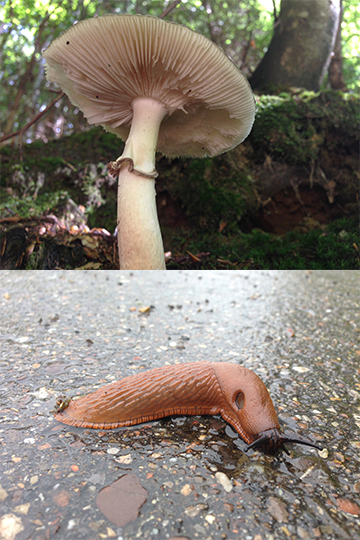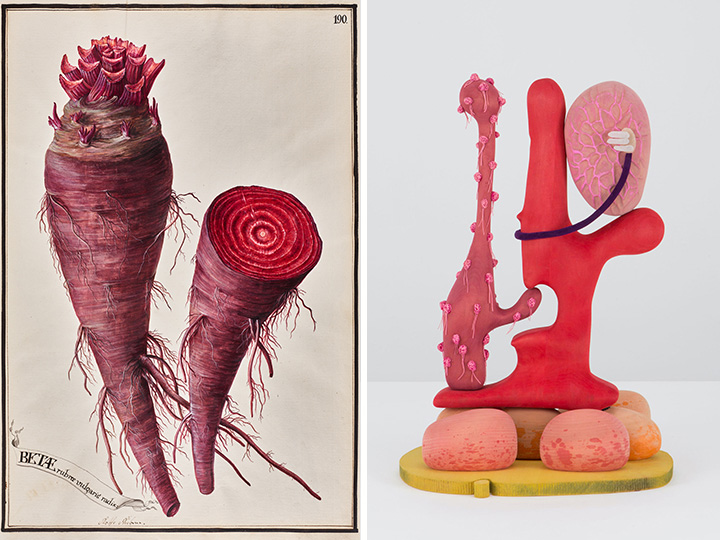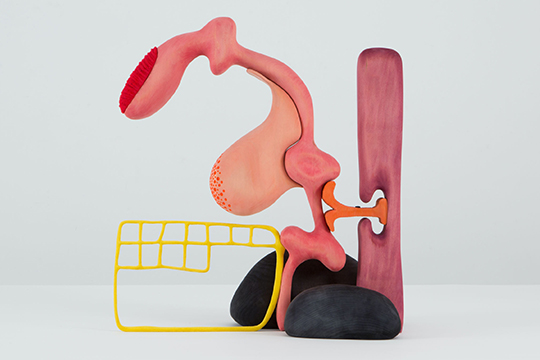In about 2014, I was asked by a prince and a princess—believe it or not—to do a residency in the south of Germany. Being a creature of habit, I assumed I would not do it, but, at the request of my wife, who said that I should absolutely take this opportunity to work in a castle, I went to Germany for about two months.
During my walks in Germany, I started to see a lot of things that I have never seen here in the US, such as beautifully colored slugs, some butterflies, all sorts of other botanical things that I was very excited about. Then I started to see a lot of mushrooms. Being a colorblind person, it's very difficult for me to see things on the forest floor, but I made it my goal every day to find some sort of species of fungus that inspired me in one way or another, which on some days would be very abundant, on other days not so. I took it upon myself to photograph most of the specimens that I found. Some days, I would come back and see that some of the mushrooms had died or become decrepit, and some days I'd see they were growing at a quick pace, and I found it extremely therapeutic. I started to see the influence in the works that I was making.
Botanical forms had always been there in my work, but I had never wanted to go along with such a pedestrian inspiration as nature. But I started to find that nature itself embodied a lot of things that I thought I had come up with or that were creations of mine, things that I thought were funny or strange. I was also completely blown away by the scale of everything. The palettes that I thought I was seeing. The way that the other animals ate things.
 Germany was a real eye-opener for me in terms of what I could see, what was there right below my nose, but I hadn't ever really considered. So, as I returned to Brooklyn, feeling a phantom sense of something missing, I started to cruise all the Tumblrs and all the internet information that I could get, and realized that what I had seen in Germany was only the entry level of fungus and that there were incredible things that only an amazing futurist fashion designer could come up with. Things like the Stink Horn mushroom. I am, as you'll see in my own work, very dedicated to the phallus as a form, and so it was very natural that I'd be drawn to fungus.
Germany was a real eye-opener for me in terms of what I could see, what was there right below my nose, but I hadn't ever really considered. So, as I returned to Brooklyn, feeling a phantom sense of something missing, I started to cruise all the Tumblrs and all the internet information that I could get, and realized that what I had seen in Germany was only the entry level of fungus and that there were incredible things that only an amazing futurist fashion designer could come up with. Things like the Stink Horn mushroom. I am, as you'll see in my own work, very dedicated to the phallus as a form, and so it was very natural that I'd be drawn to fungus.
From fungus, I started to think more of plant life in general and started to research all sorts of things that fell into my element of work, such as death, reproduction, disease, aging, sexual organs, orifices, peduncles, protuberances, mathematics, things of this sort. And I started to realize all these things that you think you invented, nature thought of them first. Beautiful textures and colors and divine geometries—just real brilliance of pattern, humor, theater, and a way in which nature embodies thoughts. If we look at nature as metaphor, we see it almost anthropomorphically different types of personality traits, different ways in which all sorts of things, that maybe we think of as human conditions, of creative residue, present themselves somehow in nature.
Then I started to also think that things in the animal kingdom also embodied lots of my interests, such as tubes or phalluses. I mean, there are so many different crazy aberrations of nature, marriages of botany and the animal kingdom. So, I also realized that I owe great homage to the deep sea and the microscopic diatoms of algae and their divine geometry, their Gaudí-esqueness. In the very deepest depths of the sea are these creations, which I think could easily be surrealist, you know, Leonora Carrington's or something, something that you could not imagine on the strongest psychedelics. Maybe the deep sea is something that resonates with me the most, and I found this great Arthur C. Clarke quote: “We seldom stop to think that we're still creatures of the sea, able to leave it only because from birth to death we wear the water-filled space suits of our skins.”
I went from these kinds of things to do more research, looking inside of animals, inside of organs, to see other worlds inside those worlds, where you're starting to understand not only the way that things look but the way that things function. And it's on this level that I started to get very inspired. I found that the explanations for the way that proteins work and DNA or the way that the circulation system works or the homeostasis of the kidneys—that these things, for me, could also be read in terms of narrative spirituality or psychology. And that these systems of respiration or circulation held within them some sort of other logic that I think that painters and sculptors and dancers and people maybe subconsciously apply to their movements or their narratives, even the way that geology is formed. All these things tend to have a way of working themselves into artists’ ideas and artists’ narratives. There are all sorts of other deep, visual languages that resonate with artists.
Starting in the year 1790, there was a book of botany called the Codex Liechtenstein which took—it’s 14 volumes—30 years to make. Some of Europe's foremost botanical artists made this book. It begins in this very strange, terribly perspectival amalgamation of classical thought and all these other things which I find extremely charming and almost surreal. But as botanical texts do, it goes into a very in-depth series of looking at the herbs from that area and then also other plants that they could grow in a hothouse on the premises. But for me, the way that I think I read this kind of material is in my wonderment of what nature creates and how absurd and sexualized and violent and gnarled and ugly and warty and mathematical it could get, so that something like this thing that looks like … I don't really know exactly what it is—it's part of a tree but it has all these appendages. I find it incredibly beautiful. The lusciousness of the flowers, the way that you feel that the artists painting it were actually experiencing some sort of erotic bliss from painting the leaves and all the innards and all the seeds, and that even though it's not pornographic, there's a hidden pleasure in the way that botanical artists drew this kind of stuff. So, I'm very fascinated by this, and a huge fan of looking, in general. I think it's a lost art and that a lot of artists are not able to have the patience to look at things, and so I feel like the botanical drawings are an area where you really, really feel that patience.

In my own work, it may be important for people to understand, I didn't always work in abstract terms. I often worked in representation and as I went toward abstraction there were a lot of moments where I found it was almost impossible for me to talk about my work. I hadn't really developed a language in which to speak about abstraction, at least with any sort of confidence, and I came across this book called The Science of The Dogon.
The Dogon are a tribe from West Africa that, to the best of my knowledge, did not have a written language, but had an incredibly advanced creation mythology told through sculpture and architecture, and this guy, Laird Scranton, who's not an expert really on anything that I can tell—it’s kind of a piece of gorilla scholarship, he's a computer guy—wrote a book that overlaid Egyptian creation mythology, the Dogon mythology, and contemporary quantum physics and found that there's this incredible way in which the Dogon, even without microscopes or without necessarily knowledge of the elements of matter, had this weird intuitive understanding of the elements of matter. There is a scene taken from a door of a granary of the Dogon creation mythology talking about one of the most elementary particles: the shape of an electron orbit. There is another example the Yala egg, which is also one of the ways that they explain the splitting of man and woman, that relates to our modern scientific understanding of a chromosome splitting. So, I started thinking to myself, of course! What if for humans, since we have evolved from microscopic sea creatures to multi-organism, walking, talking, conscious people, what if, even though it's impossible to prove this, that at each one of those stages, there is something stored in our DNA that we can access. We don't understand when we use abstraction necessarily that we're communicating something empirical, but what if it's possible that we have some sort of inherited memory? I really believe that's possible. I think you see it in Jean Arp’s work. I think you see it in a lot of other artists.
Most of my work is what you could call biomorphic abstraction, but I often interpret it in terms of reproduction, death, disease, decomposition, sexuality, and then on top of that, I think, especially recently, there is a latent kind of cybernetic vibe, so that we're looking at nature but also nature as its aided by technology somehow. One of the things that's most important in my work is how the materials feel soft. You get the feeling that it's not wood, that it might be some sort of soft material, but almost all of this is made out of wood. I'm very dedicated to things that happen in nature that could be interpreted on a different level, so for example the title of this piece is Trophallaxis. Trophallaxis is a scientific word that describes how one animal regurgitates food and transfers it to their offspring, like a mama bird to a baby bird. So, in my mind, there's a quality in this that's about a kiss or something that's very tender. But these are the ways in which I use nature in my work, where I create an image and then through sculpting the image and thinking about the image, I then go into some sort of scientific research about something like trophallaxis.
 I'm very interested in tumors, the way that things grow, the terminology for these kinds of things. Sometimes growth is a positive thing, sometimes growth is a negative thing. I think it's interesting that that can happen.
I'm very interested in tumors, the way that things grow, the terminology for these kinds of things. Sometimes growth is a positive thing, sometimes growth is a negative thing. I think it's interesting that that can happen.
I often work with the body, but I work in it in such a way that it's completely abstracted, and that often there's a part of my work that's very ritualistic and tied to mysticism or at least the illusion of that, and in which sometimes the body is a stand-in for a funeral or for a passing or an energy exchange.
I often work singularly on discrete sculptures, but the real passion of mine is to work with all the works in concert, where I'm presenting a series of objects in a kind of ordered procession in which somehow an idea builds upon itself as it exchanges and so as it changes from the front to the back of an installation, so for a body of work like this, I had always thought of this work as being about the gestation of any sort of organism from birth to death, and so you're starting out at the front with the beginning of an organism, the splitting of the chromosomes, the penetration of how it happened, the splitting of the eggs, the twinning, like all this kind of stuff that happens in nature. Of course, it's not didactic, so my reading is just an example of a possible reading, but I think that the building blocks of the language are there. The soft material, the way that things fit into each other, that they transmit an idea that has something to do with life cycle or the small circle of living matter. And I imagine that this work was organized as a model of a body, starting on the back wall as the kind of brain center and then working away from that into different areas that could be about respiration, digestion, homeostasis, gall bladders, appendices, antibodies, like these kinds of things. And at the same time, obviously there's often a performative or mystical quality.
This is a large installation, is about what happens to the body or the soul as it goes from the planet. The world of the living to whatever is next, whether that's nothingness or whether it's somethingness, that this is like a mythology that the Greeks investigated, the Egyptians investigated. It's the story of what happens to physicality once you leave the material world.
Matthew Ronay: The Crack, the Swell, an Earth, an Ode is on view at the Nasher Sculpture Center from October 22, 2022 - January 15, 2023.
Artist Matthew Ronay studied at the Maryland Institute College of Art before earning his MFA from Yale University in 2000. Ronay has exhibited at institutions including Kunsthalle Lingen, Germany; University of Louisville, Kentucky; Artspace, San Antonio, Texas; Serpentine Gallery, London; Sculpture Center, New York; Center for Curatorial Studies, Bard College, New York; Crystal Bridges Museum of American Art, Bentonville, Arkansas; Kentucky Museum of Art and Craft, Louisville, Kentucky; and Parasol Unit Foundation for Contemporary Art, London. Ronay participated in the 2013 Lyon Biennale, curated by Gunnar Kvaran, and the 2004 Whitney Biennial. In 2016, his work was the subject of solo presentations at the Blaffer Art Museum, Houston, Texas and the Pérez Art Museum Miami, Florida.
This text was excerpted and adapted from a lecture delivered on December 20, 2018, at the Nasher Sculpture Center as part of the 360 Speaker Series.
TOP: Matthew Ronay, The Crack, the Swell, an Earth, an Ode (detail), 2022. Basswood, dye, gouache, flocking, plastic, steel, cotton, epoxy, 37 3/4 x 284 x 13 in. (95.9 x 721.4 x 33 cm). Matthew Ronay. Courtesy of the artist and Casey Kaplan, New York.
INSIDE: Matthew Ronay nature walk images of mushroom and slug, courtesy of the artist.
CENTER, LEFT: Joseph Anton Bauer (1756–1831), Ferdinand Lukas Bauer (1760–1826), Franz Andreas Bauer (1758–1840), Hortus Botanicus or Liber regni vegetabilis, plants assembled by Norbert Boccius, Prior of the Monastery of the Brothers of Merci in Feldsberg (Valtice), Volume V, 1780. Black ink, watercolour and gouache on paper, 200 folia, bound, half leather binding. LIECHTENSTEIN. The Princely Collections, Vaduz–Vienna. Inv. GR 527.5
CENTER, RIGHT: Matthew Ronay, Couplings, 2017. Basswood, dye, gouache, flocking, plastic, steel, polycarbonate, 26 1/2 x 18 x 16 1/2 in. (67.3 x 45.7 x 41.9 cm). Matthew Ronay, courtesy of the artist.
BOTTOM: Matthew Ronay, Sprout Capsule Implantation, 2017. Basswood, dye, cotton string, shellac-based primer, steel, plastic, flocking, gouache, 23 1/2 x 22 x 13 in. (59.7 x 55.9 x 33 cm). ? Matthew Ronay, courtesy of the artist.